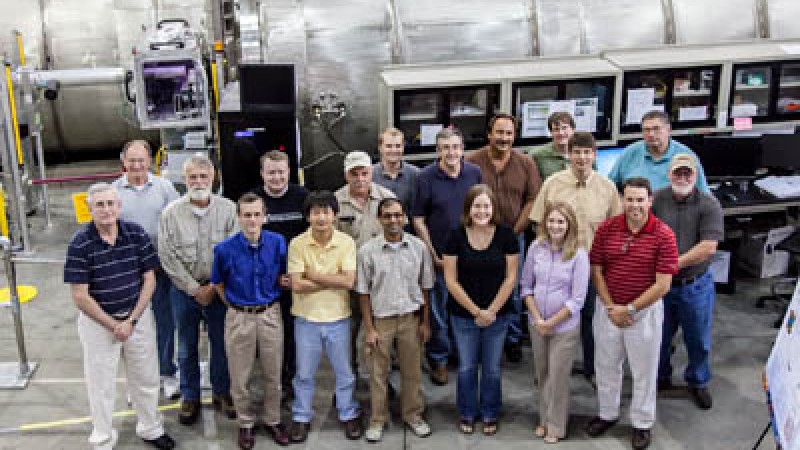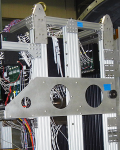Bio-SANS, the Biological Small-Angle Neutron Scattering Instrument at HFIR recently had a detector upgrade that will provide significantly improved performance that is more in line with the instrument’s capability.
Shorter experiment times are expected, which means more experiments can be performed, as well as new types of science addressed that could not be done previously, said Kevin Berry, a detector development specialist in the Neutron Sciences Directorate.
The new detector system is an array of 192 individual linear position-sensitive detectors. Each detector tube is 8 mm in diameter, 1 m in length, and filled with 3He (Helium-3) gas for neutron conversion. The tubes are oriented vertically and arranged into two rows of 96 tubes each, spaced to provide an active area of 1 × 1 m, equivalent to that of the original detector.
For ease of assembly, handling, and testing, the detector array was designed to be modular, with eight tubes per module. “This design allows better access for maintenance and repair, compared with the original; now, problem modules can be replaced individually,” Berry said.
The original detector was housed in a common enclosure. Detector repair consisted of removing the entire system and returning it to the factory, leading to long instrument down times.
Plans are in place to add additional detector banks for recording data at higher scattering angles than is currently possible.
This new detector is modeled after one that was installed at the Extended Q-Range SANS instrument at SNS in 2008 and is identical to the upgrade to the General-Purpose SANS instrument in 2011.
“Since the upgrade at GP-SANS, the detector system has been shown to be capable of operating at count rates one to two orders of magnitude higher than before,” Berry said.
For experiments with strongly scattering samples, this means that shorter experimental times and therefore higher throughput can be achieved. With the old detector, data rates from strongly scattering samples had to be slowed down by attenuating the available neutron beam.
For Bio-SANS, the higher count rate improves the capability to study samples that have a low signal over intrinsic background, namely small proteins at low concentrations, and contrast studies for small domains in large multi-domain protein molecules.
Higher count rates will also allow new types of experiments such as faster time-resolved studies than were previously feasible, with sample changes that occur in the second to sub-second time-range.
Bio-SANS was designed for the analysis of the structure, function, and dynamics of complex biological systems. It is the cornerstone of the Center for Structural Molecular Biology (CSMB) at Oak Ridge National Laboratory. The detector modules were manufactured by GE Reuter-Stokes, Twinsburg, Ohio. Funding for the detector upgrade came from the U.S. Department of Energy Office of Basic Energy Sciences and the Office of Biological and Environmental Research.






